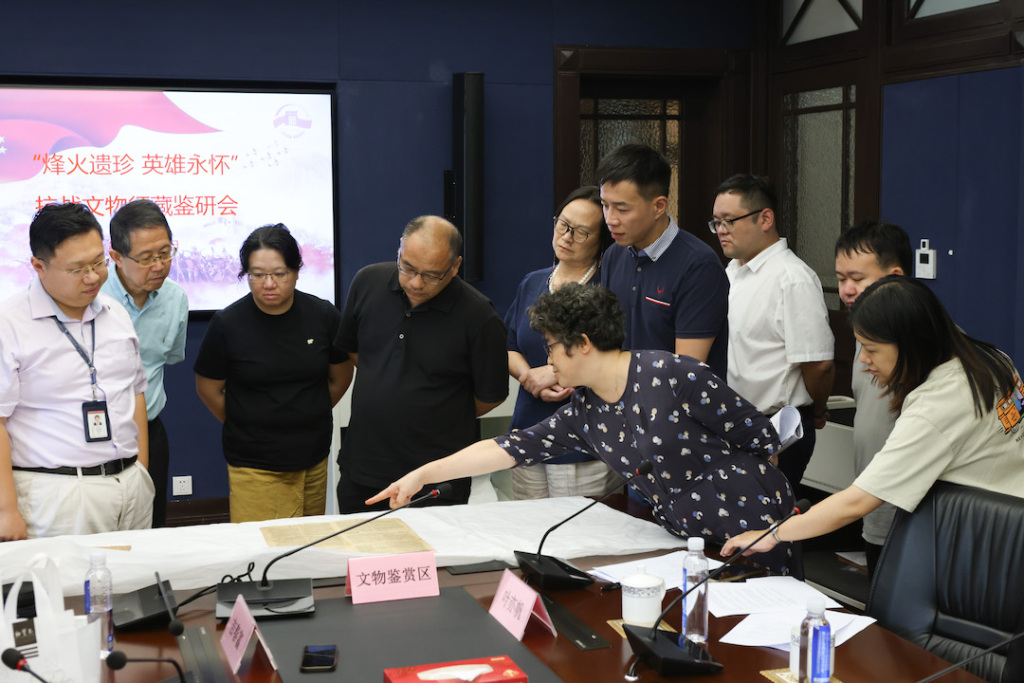
What kind of stories of the War of Resistance Against Japanese Aggression are behind the yellowed documents, weathered objects and old photos with the smell of gunpowder?
On September 18, 2025, the Shanghai History Museum (Shanghai Revolutionary History Museum) held the "Treasures Left Behind in the War, Eternal Commemoration of Heroes" Anti-Japanese War Relics Collection and Appraisal Conference, focusing on displaying the precious anti-Japanese war themed cultural relics and documents collected in recent years, and revealing the more than 80 years of historical memory behind them.

The scene of the collection and research meeting of Anti-Japanese War cultural relics
This year also marks the 80th anniversary of the victory of the Chinese People's War of Resistance Against Japanese Aggression and the World Anti-Fascist War. Each cultural relic silently tells the story of the war-torn era, the ups and downs experienced by ordinary people, and the passion and perseverance of their ancestors in the war of resistance.
Four donor representatives shared their experiences at the event. Zhao Xiaoming shared the story of how his father, Zhao Jian, met Zhuang Suo; Zhao Ming shared two stories about Li Jishen's dedication to the War of Resistance; Ji Chunfu explained the origins of his donated collection; and Gu Lidan recounted his ancestors' experiences during the War of Resistance, hoping that more young people would remember history.

The scene of the collection and research meeting of Anti-Japanese War cultural relics
During the appreciation session, a flag covered in inscriptions particularly caught their eye. "Crossing the Yangtze River on the 13th," "Tongji University on the 7th," "Fall of Dachang Town"... This flag, signed by the Japanese Shanghai Expeditionary Force, clearly records the unit's actions from 1937 to 1939, providing direct evidence of the Japanese invasion of China. Ye Yifan, curator of the Exhibition Education Department at the Shanghai History Museum (Shanghai Revolutionary History Museum), told The Paper that the artifact was purchased in Japan by a veteran history enthusiast and donated to the museum free of charge.

Signed battle history flag of the Shanghai Expeditionary Force of the Japanese Invaders
The receipt of the "Greater Shanghai Gas Co., Ltd." provides tangible evidence of the Japanese army's economic domination of Shanghai. The sentimental poems written by Wang Jiting, a group of scholars from Baoshan and Jiangwan, after the January 28 Incident, reveal the immense toll the war exacted on ordinary people.

Wang Jiting's Collection of Poems on the February 28th Incident
During the struggle for national salvation, people from all walks of life in Shanghai actively participated in the war effort on various fronts. For example, a congratulatory scroll from Hujiang University's Zheng Zhangcheng to Tu Yuqing in the fall of 1946, likely congratulating Tu on her appointment as president of St. John's University in Shanghai, mentions the couple's "eight years of shared hardship" during the war, reflecting their commitment to education during the war. Furthermore, images such as propaganda photos from the Ant Society's propaganda team and group photos of representatives from the Shanghai Northeast Volunteer Army Support Association also showcase their passion and perseverance.

A running script poem by Zheng Zhangcheng of Hujiang University in congratulations to Tu Yuqing in 1946
Zhou Zheng, deputy director of the Memorial Hall of the First Congress of the Communist Party of China, Huang Wei of the Shanghai Library, and Lin Jie of the Memorial Hall of the Battle of Shanghai evaluated the exhibited collections. From a professional perspective, they affirmed the value of the collections such as the New Fourth Army armbands, and pointed out that this batch of collections has diverse and life-like characteristics. They also hope that in the future, they can combine resources from various parties to revitalize the museum collections and recreate the historical scene.

1938 signed edition of Red Star Over China by Edgar Snow
Over the years, the Shanghai Museum of History (Shanghai Revolutionary Museum) has accumulated a comprehensive collection of artifacts from the War of Resistance Against Japanese Aggression, encompassing evidence of Japanese aggression, civilian support, and cultural resistance. Over 70% of the artifacts and documents displayed at this collection appraisal and research conference were donated by citizens from all walks of life. For example, the Hu Jinxian collection includes not only signed copies of Edgar Snow's "Red Star Over China" and "Red Star Over China: A Sequel," but also guestbooks written by wounded and sick soldiers and doctors during her time as a nurse at a hospital for wounded soldiers. These collections showcase foreign support for China's war of resistance and document the struggle from a personal perspective. The New Fourth Army armband on display at the event was designed by Zhuang Suo (originally named Zhuang Wuzhou), the subject of another collected photograph. The photo's owner, Zhao Jian, also learned sketching from Zhuang Suo and became a comrade in the New Fourth Army.
This batch of anti-Japanese war relics not only carries Shanghai’s red spirit and witnesses the history of the war, but also integrates individual memories into the city’s memory, giving the weight of history a more solid foundation.

1945 Dazhong Daily reporter's ID (top left) 1941 New Fourth Army armband (bottom left) Photo of Zhuang Suo (right)
According to the museum, since 2018, the Shanghai Museum of History (Shanghai Revolutionary Museum) has been continuously collecting artifacts to enrich its collections. The museum's collection focuses on the War of Resistance Against Japanese Aggression in Shanghai, but also covers other regions. The collection covers the period from the September 18th Incident to the early stages of the war. As of the second half of 2025, over 200 artifacts and documents related to the war had been collected, including many valuable historical materials and unique to the city.


